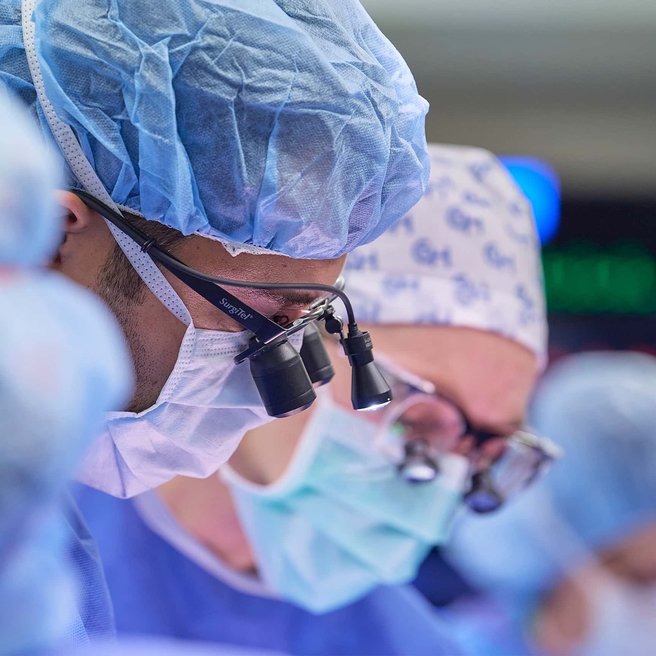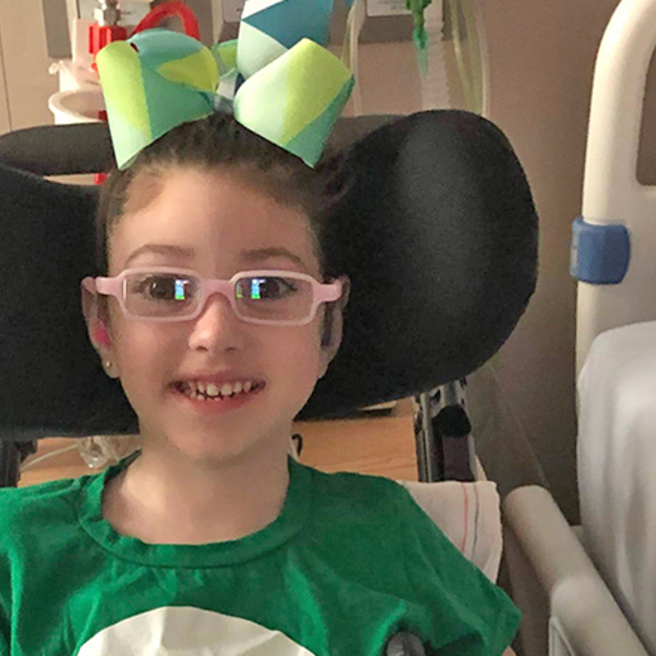What is neuromuscular scoliosis?
Neuromuscular scoliosis is a sideways curvature of the spine that is often caused by muscular, nerve or neurological disorders, such as cerebral palsy and spina bifida. Instead of a straight line down the middle of the back, a child with neuromuscular scoliosis has a spine that looks more like a letter “C.” The spine also may be rotated or twisted, pulling the ribs along with it to form a multidimensional curve.
Neuromuscular scoliosis is the second most common form of scoliosis, next to idiopathic scoliosis. It is more severe in patients whose disease prevents them from walking.
Neuromuscular scoliosis can continue to worsen well into adulthood. As the spinal curve progresses, it may cause problems with sitting, balance and breathing, and could possibly lead to thoracic insufficiency syndrome.
Causes of neuromuscular scoliosis
Neuromuscular scoliosis is caused by poor muscle control, weakness or paralysis, and neurological (nerve) problems associated with underlying conditions such as:
- Cerebral palsy
- Spina bifida
- Muscular dystrophy (including Duchenne muscular dystrophy)
- Paralytic conditions, such as polio or spinal cord injury
- Malignant musculoskeletal tumors and benign musculoskeletal tumors
Signs and symptoms of neuromuscular scoliosis
Common symptoms of neuromuscular scoliosis include:
- Deteriorating ability to sit
- Change in your child's overall position (e.g., leaning toward one side or in an uneven posture)
- Increasing need to use arms for seating support
- Uneven shoulder heights, shoulder blade heights, hip heights and/or buttocks
Testing and diagnosis of neuromuscular scoliosis
At Children’s Hospital of Philadelphia (CHOP), our orthopedic physicians will complete a full medical and family history, perform a physical examination and visual inspection of your child's spine, and review any diagnostic tests to determine the nature, extent and effects of your child's scoliosis and underlying neuromuscular disease.
A team of clinical experts will evaluate your child’s nutritional status, lung and heart function, joints and extremities, as well as balance and ability to walk.
X-rays are the primary diagnostic tool for all forms of scoliosis to show abnormal spinal bones and the precise angles of curvature.
Other tests used in evaluation and treatment of neuromuscular scoliosis may include:
- EOS imaging, an FDA-approved imaging technology that uses an ultra-low dose of radiation to create three-dimensional models from two planar images. Unlike a CT scan, EOS images are taken while the child is in an upright or standing position, enabling improved diagnosis due to weight-bearing positioning.
- Magnetic resonance imaging (MRI), which uses a combination of large magnets, radiofrequencies and a computer to produce detailed images of organs and structures within the body. An MRI does not expose your child to radiation.
- Computed tomography (CT) scan, which uses a combination of X-rays and computer technology to produce cross-sectional images ("slices") of the body including bones, muscles and organs.
- Ultrasound, which uses ultrasonic waves to image internal body structures and muscles. An ultrasound does not expose your child to radiation.
- Pulmonary function tests, which measure how well your child's lungs take in and release air, and how well they move gases (such as oxygen) from the atmosphere into your child's body.
Treatments
At Children's Hospital, we practice collaborative, family-centered care. Our multidisciplinary team includes world-renowned orthopedic physicians and surgeons, pediatric nurses, physical therapists, neurologists, rehabilitation doctors, therapists, social workers and others who specialize in pediatric patients. Together, we partner with you to treat your child with neuromuscular scoliosis.
Treatment varies according to the type and severity of your child's neuromuscular scoliosis.
Nonsurgical options for neuromuscular scoliosis
The following nonsurgical options are available to control spinal curves and improve your child's quality of life with neuromuscular scoliosis:
- Back bracing to support the spine
- Wheelchair modification
- Physical therapy
Members of your child's healthcare team can also offer suggestions on how to adapt your child's everyday environment to improve his or her mobility.
Surgical options for neuromuscular scoliosis
If your child needs spine surgery to treat neuromuscular scoliosis, the type of surgery recommended will depend on the degree of your child's spinal curve, your child's age and stage of growth.
The most common spine surgeries are:
- Implanting growing rods — This procedure is appropriate for children who are still growing.
- Spinal fusion — This procedure is best suited for children who have reached skeletal maturity or for whom growing rods are not a consideration.
A third option, vertical expandable prosthetic titanium ribs (VEPTR), may be recommended for children with neuromuscular scoliosis that is also affecting their rib and lung development, causing thoracic insufficiency syndrome. Left untreated, thoracic insufficiency syndrome can be fatal.
Because neuromuscular scoliosis is often associated with other underlying conditions — such as spinal muscular atrophy — your child's care team will work closely with specialists from neurology, pulmonology, gastroenterology and others to treat your child's overall health.
We offer a wealth of resources about how to prepare your child for surgery, what to expect during surgery and specific ways we make safety in surgery a top priority.
Growing rods and VEPTR
Growing rods and VEPTR can stabilize and straighten the spine, as well as correct rib cage problems.
Growing rod surgery is done through the back of the spine. In most cases, the curve in the child's back is spanned by one or two rods under the skin to avoid damaging the growth tissue of the spine. The rods are attached to the spine at two spots — above and below the curve.
In VEPTR surgery, the expandable titanium ribs are implanted into a child's back and chest and anchored to the spine, ribs, pelvis or collarbone. The VEPTR helps to correct and stabilize the curved spine, allowing your child's ribs, lungs and spine to grow and develop more fully.
Whichever device is implanted will need to be expanded or lengthened every six to eight months as your child grows. Your child will need to return to the hospital for minor surgery to adjust the rods until skeletal maturity (about 14 years old for girls and 16 years old for boys).
Spinal fusion
If your child has stopped growing — or growing rods are not a viable surgical option — spinal fusion may be recommended as an option to permanently correct and stabilize the spine. In this procedure, the abnormal curved spinal bones may be realigned, fused together and metal implants inserted to correct the curvature.
Post-op recovery
Most patients receiving any type of spinal surgery to treat neuromuscular scoliosis will spend between five and 10 days in the Hospital, during which time caregivers will closely monitor the child's lung function, fluid and nutrition levels.
Our care team will also encourage your child to move around as soon as possible and modify a wheelchair for your child to improve his seated position, if appropriate.
About the diagnosis
10 facts about scoliosis
A scoliosis diagnosis can leave parents with a lot of questions. Learn essential scoliosis facts parents and caregivers should know about this common, treatable condition.
Follow-up care
The Hospital is committed to partnering with you to provide the most current, comprehensive and specialized follow-up care possible for your child.
Patients who receive surgery for neuromuscular scoliosis at CHOP are followed closely for the first one to two years after surgery, then at regular intervals afterwards at our Main Campus or one of our CHOP Care Network locations.
CHOP was the first institution in the U.S. to introduce “EOS micro-dose” for use in scoliosis follow up. Micro-dose uses one-third of the standard EOS radiation dose, further reducing radiation exposure for children who may require frequent imaging.
We also recognize your child's pediatrician as an important part of the care team, and will provide regular updates on your child's progress. If your child requires continued care into adulthood, we will help transition care to an adult orthopedic team.
Outlook for children with neuromuscular scoliosis
Outcomes for children treated for neuromuscular scoliosis are typically good. The outlook for your child depends more on the nature, severity and effects of his neuromuscular disease, and less on the scoliosis.
With successful spinal surgery and careful post-operative care, a straighter spine can improve your child's breathing, decrease his or her vulnerability to respiratory problems, and improve the ability to sit in a stable seating position to promote activities of daily living.

Why choose CHOP
By sharing our surgical knowledge, clinical experience and innovative research, our program offers a depth and breadth of experience treating spine conditions that is unparalleled in the region.
Resources to help
Neuromuscular scoliosis Resources
Spine Program Resources
We have created video, audio and web resources to help you find answers to your questions and feel confident with the care you are providing your child.
Reviewed by David A. Spiegel, MD


